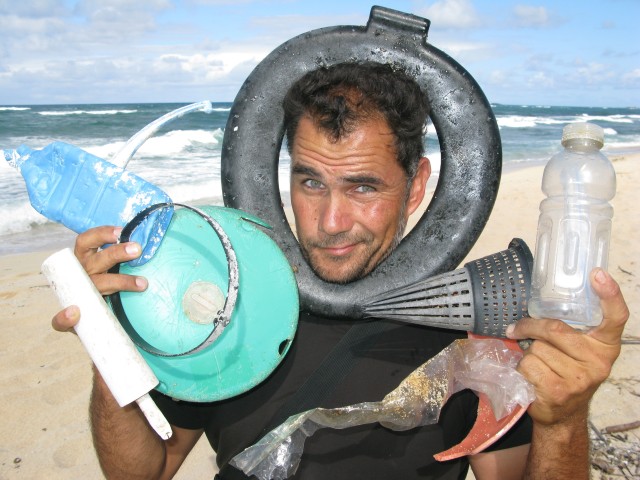#377) Good Buoy: Marcus Eriksen Shows a Trillion Ways to Communicate Effectively for the Oceans
December 12th, 2014
It’s about the power of the singular narrative. It’s contrary to the mind of a scientist who wants to tell the world EVERYTHING. For the case of plastics in the world’s oceans, Marcus Erikson of 5 Gyres has given the media a single number — 5.25 trillion pieces of plastic now adrift at sea. Is that number accurate? It’s close enough — the equivalent of just saying there’s A LOT of plastic out there. But it’s a specific number, and that’s what the masses like. Which is why there’s now a minor tsunami of media attention in the NY Times, Washington Post, Nature World News and a trillion other media outlets.
HOLY CRAP, BATMAN! Marcus Eriksen frames himself amidst some of the 5.25 trillion pieces of plastic he is determined to rid the oceans of.
ONE ISSUE, ONE NUMBER
This is what the group 350.org did with the selection of their name. They decided to brand the entire climate issue with a single number, which was bold and wise. The payoff isn’t immediate — it’s a more long term investment, likely to be worth it only if the organization sticks around and receives a lot of media attention, as they have.
The real benefit is when there are discussions of atmospheric carbon dioxide levels — a snoozer of a topic — and suddenly there is a ring to one particular number — 350. Suddenly people find it a little bit easier to follow the discussion, and some of them hit that moment of realization of, “Oh, that’s why they named themselves that.” That is the eventual communications payoff, which can happen.
A TRILLION REASONS TO SIMPLIFY
In the case of plastics in the ocean, if you’re going to say there’s a lot of plastic out there, then please give us a number and make sure it’s an impressive one. That’s what Marcus Eriksen just did.
It has the right term associated with it — “trillion.” That’s great. You might add “give or take a few trillion,” but who cares. This is about conscientious communication — conforming your messaging to the constraints of the media world (the need for simplicity and singularity) yet being conscientious and knowledgeable enough to make sure your guesstimate is reasonable and responsible, as he’s done.
It’s what was done with terrorism in the Bush era by distilling it down to basically red, green, yellow, orange, whatever. The pundits loved making fun of how stupid that seemed, but the fact was it worked for the masses. Same thing with the deck of cards in the search for terrorism suspects. Simple, easy to ridicule, but effective for mass communication.
The bottom line is that if all you’re ever going to do is ridicule the simplicity of mass communication, then you’re going to end up in your ivory tower reaching no one, but proud of how you never compromised all your cherished complexity. Which in the end is pretty arrogant.
CORAL REEF MESS-AGING
This is what I’ve tried to say to the sloppy, non-strategic communications efforts of the coral reef community. What’s their “one number” for the state of coral reefs globally? There is none. They refuse to let their topic be simplified — constantly giving you the shopping list of threats to coral reefs. And as a result they have put “the mess” into their messaging. Are coral reefs today half of what they were a century ago? Ten percent? The same? No one can tell you and no one is brave enough to even try at a broad level.
The net result is an ineffective blur. It’s a world where tourists can visit tropical destinations, dive on degraded coral reefs, and feel they are seeing the same thing as a century ago. That’s how the tourism brochures present it. That’s how the Tourism Development Council of the ravaged Florida Keys presents it as I learned a decade ago. And that’s how the guilt-free tourists of the world view it.
Mass communication is not as easy as most people think it to be. It needs scientists who have media savvy.
Kudos to Marcus Eriksen for being one such individual.
AND … HE USED EXCELLENT ABT FORM
One more piece of communication excellence in this study. Look at the abstract of the PLOS ONE paper that Eriksen and colleagues authored. There’s the ABT structure in action. They set up their context with a first phrase (the AND element), they hit their contradiction word with “yet” (the BUT element) then they head off in a single direction (singularity!) with “Here we report …” (the THEREFORE element). This puts them in the same company as Abe Lincoln with his Gettysburg Address and Watson and Crick with their initial description of the structure of DNA. Good communicators converge on the ABT naturally, just like this:
“Plastic pollution is ubiquitous throughout the marine environment, yet estimates of the global abundance and weight of floating plastics have lacked data, particularly from the Southern Hemisphere and remote regions. Here we report …”
